
Are you looking to create a kitchen that is both stylish and eco-friendly? With the right choices, it’s possible to design a space that reduces your ecological footprint while promoting environmental protection. This article will cover essential tips for selecting sustainable materials for cabinets and countertops, choosing energy-efficient appliances, and implementing water conservation strategies. By following these guidelines, homeowners can enjoy a beautiful kitchen that minimizes oil consumption and maximizes daylight, all while addressing the growing need for sustainable living.
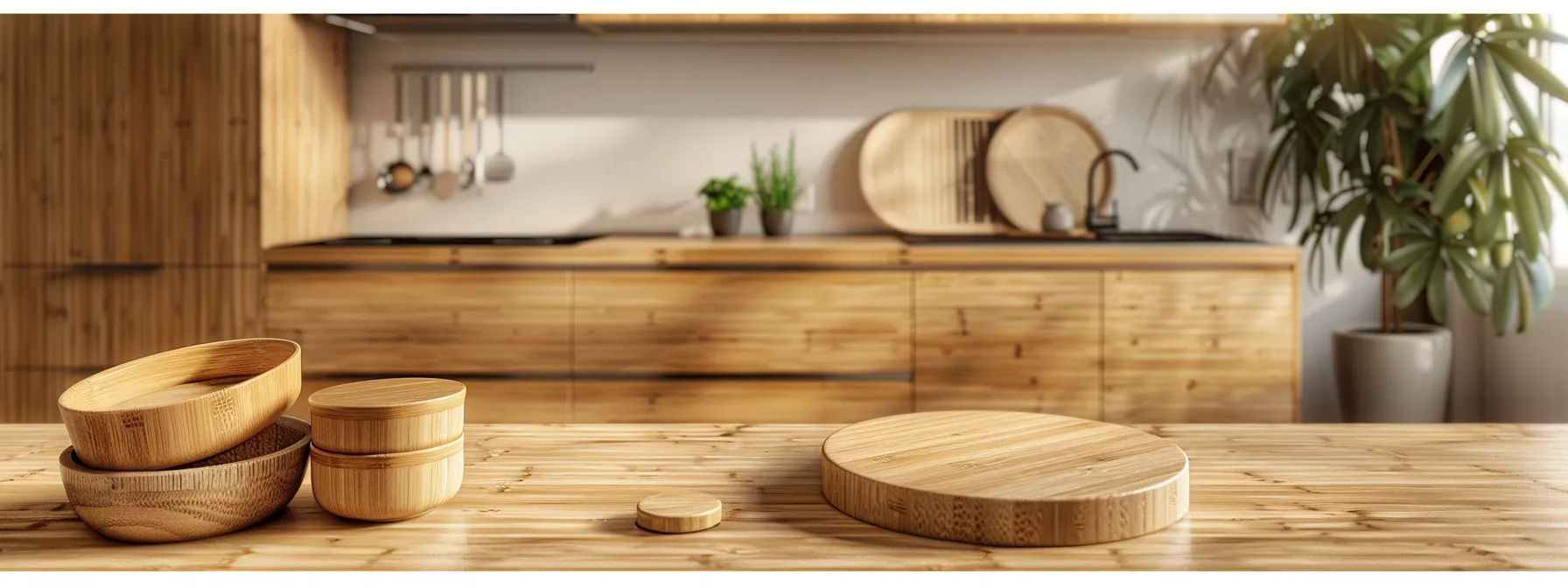
Choosing sustainable materials for kitchen cabinets and countertops is essential for eco-friendly kitchen design. Options like bamboo and reclaimed wood offer benefits such as reduced greenhouse gas emissions and lower manufacturing impacts. Selecting low-VOC finishes and exploring eco-friendly countertop options, including engineered stone, further enhance sustainable living. Sourcing materials locally also minimizes carbon footprints while assessing durability ensures long-lasting choices.
Bamboo and reclaimed wood are excellent choices for kitchen cabinets and countertops, particularly in eco-friendly designs like naked kitchens. Bamboo is a rapidly renewable resource that grows quickly, making it a sustainable alternative to traditional hardwoods. Reclaimed wood, on the other hand, promotes recycling by repurposing materials that would otherwise contribute to waste, reducing the need for new fiberboard and minimizing environmental impact.
Incorporating these materials not only supports sustainable living but also enhances the aesthetic appeal of a kitchen. Both bamboo and reclaimed wood offer unique textures and colors, adding character to the space. Additionally, using these materials can lead to energy savings, as they often require less energy to produce compared to stone or other manufactured options, making them a smart choice for environmentally conscious homeowners.
Selecting low-VOC finishes and paints is a crucial step in creating an eco-friendly kitchen. These products emit fewer volatile organic compounds, which can improve indoor air quality, making the kitchen a healthier space for cooking and family gatherings. Homeowners should look for finishes that are specifically labeled as low-VOC, ensuring that their choices align with sustainability goals while maintaining the beauty of materials like bamboo and porcelain.
When choosing finishes, it is also important to consider their durability, especially in high-use areas like kitchens. A quality low-VOC finish can withstand the wear and tear from daily activities, including the heat and moisture from dishwashers. By opting for these sustainable options, homeowners can enjoy a stylish kitchen that supports their commitment to environmental responsibility:
When exploring eco-friendly countertop options, homeowners can consider materials such as recycled glass, bamboo, and quartz. Recycled glass countertops not only provide a unique aesthetic but also contribute to home improvement by reducing waste. Bamboo, known for its rapid growth and sustainability, offers both utility and longevity, making it an excellent choice for those focused on eco-friendly interior design.
Another viable option is quartz, which is engineered from natural stone and recycled materials, ensuring durability and low environmental impact. This material stands up well to daily use, making it ideal for busy kitchens. By selecting these sustainable countertops, homeowners can enhance their kitchen’s functionality while supporting a commitment to sustainable living and responsible home improvement practices.
Sourcing materials locally is a vital step in reducing the carbon footprint associated with kitchen renovations. By choosing local suppliers for countertops and cabinetry, homeowners can significantly decrease transportation emissions, which contribute to deforestation and environmental degradation. This practice not only supports the local economy but also promotes the use of renewable resources, ensuring that the materials used in the kitchen are both sustainable and responsibly sourced.
Additionally, local materials often come with the added benefit of being more durable and antimicrobial, which is essential for maintaining a healthy kitchen environment. Homeowners can find unique options that reflect their lifestyle while minimizing their impact on the planet. By prioritizing local sourcing, they can create a beautiful, eco-friendly kitchen that aligns with their values and commitment to sustainable living.
When assessing the durability and lifespan of sustainable materials for kitchen cabinets and countertops, homeowners should consider how these choices align with principles of environmental stewardship and green building. For instance, materials like bamboo and reclaimed wood not only offer aesthetic appeal but also demonstrate resilience against wear and tear, making them suitable for high-traffic areas in kitchen renovations. Selecting building materials that are certified with an Energy Star label can further enhance energy efficiency, ensuring that the kitchen remains functional and sustainable over time.
Durability is a key factor in sustainable living, as it reduces the need for frequent replacements and minimizes waste. Homeowners should evaluate the performance of materials under various conditions, such as exposure to moisture and heat, which are common in kitchen environments. By prioritizing long-lasting options, they can create a kitchen that not only meets their design preferences but also supports their commitment to sustainability and responsible home improvement practices.
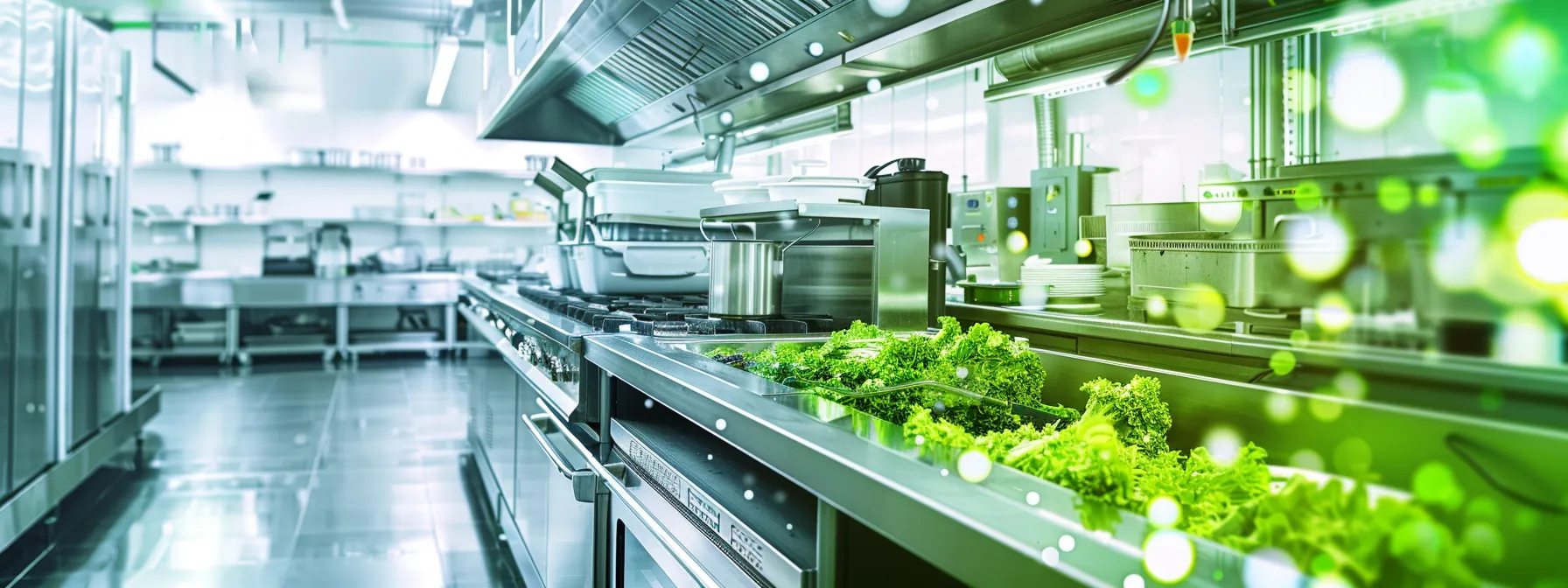
Energy-efficient appliances play a crucial role in eco-friendly kitchen design. Understanding Energy Star ratings and certifications helps homeowners select efficient refrigerators and dishwashers that minimize energy consumption. Comparing induction cooktops to traditional stoves reveals significant benefits in energy use, while smart appliances enhance energy management. Regular maintenance ensures optimal performance, contributing to sustainable living through reduced water heating and effective use of renewable energy.
Understanding Energy Star ratings and certifications is essential for homeowners looking to reduce their carbon footprint through energy-efficient appliances. These ratings indicate that a product meets strict energy efficiency guidelines set by the U.S. Environmental Protection Agency. By choosing appliances with Energy Star labels, homeowners can significantly lower their energy consumption, which not only reduces waste but also contributes to a more sustainable kitchen environment.
Incorporating Energy Star appliances into kitchen design aligns with the concept of upcycling, as it encourages the use of existing resources more efficiently. For example, energy-efficient refrigerators and dishwashers utilize advanced technologies that minimize energy use while maintaining performance. This approach not only helps in reducing the overall environmental impact but also supports a healthier lifestyle by promoting the use of sustainable materials, such as stones and recycled components, in kitchen renovations:
When selecting efficient refrigerators and dishwashers, homeowners should prioritize models with the Energy Star label, which indicates superior energy efficiency. These appliances not only reduce energy consumption but also help minimize waste that often ends up in landfills. By choosing energy-efficient options, homeowners contribute to sustainable forest management practices, as less energy use translates to lower demand for resources needed in manufacturing.
In addition to energy efficiency, it is essential to consider the materials used in these appliances. For instance, many modern dishwashers and refrigerators incorporate quartz and other sustainable materials, enhancing durability and performance. Homeowners can also look for features that promote water conservation, ensuring that their kitchen remains eco-friendly while effectively managing resources, including the water used in sinks.
Induction cooktops offer a modern alternative to traditional stoves, providing faster cooking times and greater energy efficiency. Unlike conventional stoves that heat the entire surface, induction cooktops use electromagnetic energy to directly heat stainless steel cookware, resulting in less wasted energy and quicker meal preparation. This efficiency not only saves time but also reduces energy consumption, making it a smart choice for eco-conscious homeowners looking to enhance their kitchen cabinet designs with sustainable appliances.
In addition to their energy-saving benefits, induction cooktops are easier to clean compared to traditional stoves. The smooth surface allows for quick wipe-downs, especially when paired with concrete countertops that complement the sleek design. Homeowners can enjoy a stylish and functional kitchen while minimizing their environmental impact, as the combination of induction technology and durable materials supports a commitment to sustainable living.
Utilizing smart appliances in a kitchen remodel can significantly enhance energy management and promote sustainable living. These devices often come equipped with features that allow homeowners to monitor and control energy usage remotely, ensuring that appliances operate efficiently. For instance, smart refrigerators can alert users when doors are left open, reducing unnecessary energy waste, while smart dishwashers can optimize water and energy consumption based on load size.
In addition to energy efficiency, smart appliances can also contribute to a healthier home environment by minimizing harmful substances like formaldehyde found in some traditional materials. By choosing appliances that support reuse and recycling, homeowners can further their commitment to sustainability. For example, pairing smart appliances with eco-friendly flooring options like linoleum can create a cohesive design that prioritizes both functionality and environmental responsibility.
Maintaining appliances is crucial for ensuring optimal performance and enhancing indoor air quality in an eco-friendly kitchen. Regular cleaning and servicing of energy-efficient appliances, such as refrigerators and dishwashers, can prevent the buildup of dust and debris, which may contribute to air pollution within the home. Homeowners should also check seals and filters to ensure that appliances operate efficiently, reducing energy consumption and promoting a more environmentally friendly living space.
In addition to routine maintenance, homeowners can enhance accessibility to their appliances by organizing kitchen spaces effectively. This not only makes it easier to use appliances but also encourages regular upkeep, which is essential for longevity. By prioritizing maintenance, homeowners can enjoy the benefits of their energy-efficient appliances while minimizing their environmental impact and supporting a healthier home environment.
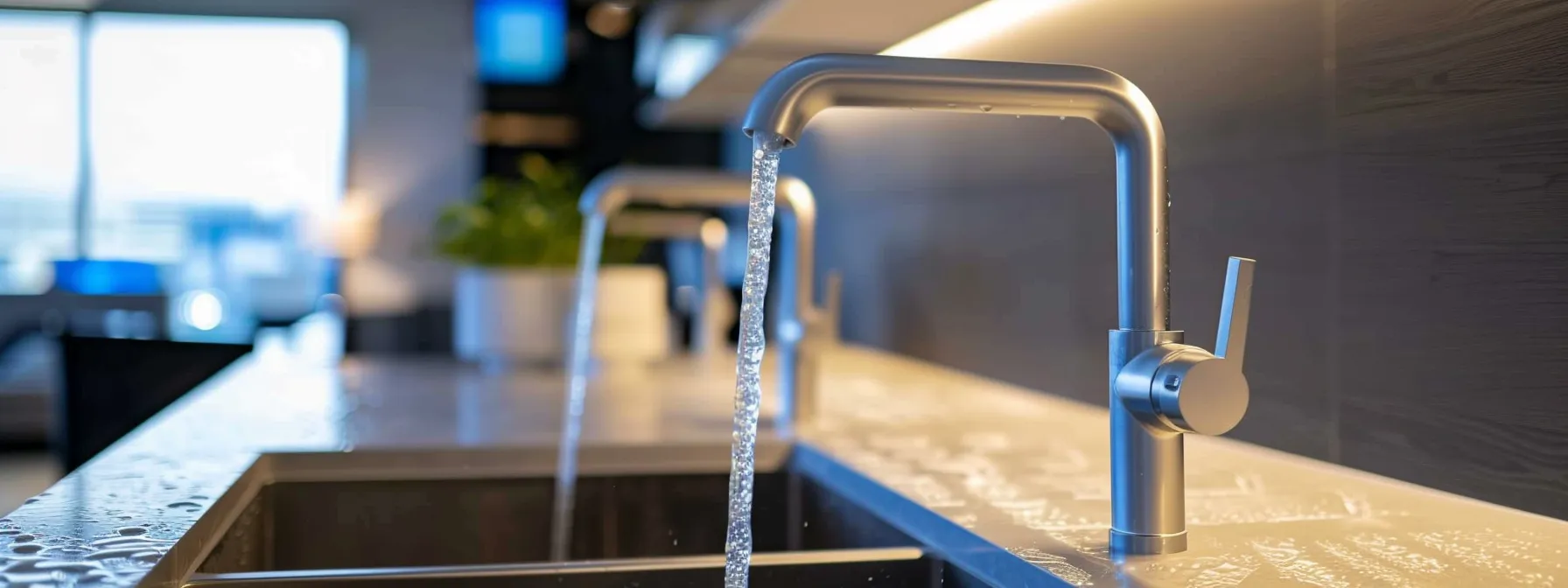
Implementing water conservation strategies in kitchen design is vital for sustainable living. Homeowners can start by installing low-flow faucets and fixtures, which significantly reduce water usage. Incorporating touchless faucet technology enhances convenience while minimizing waste. Choosing water-efficient dishwashers and implementing greywater systems for recycling water further support eco-friendly practices. Additionally, preventing leaks with proper plumbing ensures that every drop counts, contributing to responsible resource management.
Installing low-flow faucets and fixtures is a practical step for homeowners looking to enhance water conservation in their kitchen remodeling projects. These fixtures significantly reduce water usage without sacrificing performance, making them an ideal choice for eco-friendly designs. By opting for low-flow options, homeowners can contribute to resource conservation, which is essential in the fight against climate change.
In addition to saving water, low-flow faucets often come in stylish designs, including finishes like stainless steel and granite, allowing homeowners to maintain aesthetic appeal while being environmentally responsible. Choosing these fixtures not only helps in reducing water bills but also promotes a sustainable lifestyle that prioritizes efficient resource use. Homeowners can enjoy a modern kitchen that reflects their commitment to sustainability:
Incorporating touchless faucet technology in kitchen design significantly enhances water conservation efforts. These faucets use sensors to detect hand movement, allowing users to turn the water on and off without physical contact. This feature not only reduces water waste but also minimizes the spread of germs, making it a practical choice for maintaining a clean kitchen environment.
Homeowners can choose touchless faucets made from certified wood or engineered wood materials, ensuring sustainability in their kitchen design. Additionally, options that utilize resin or stain finishes can provide durability and aesthetic appeal. By selecting these eco-friendly fixtures, homeowners can create a modern kitchen that aligns with their commitment to sustainable living while effectively managing water resources.
Choosing water-efficient dishwashers is a critical step in promoting sustainable living in kitchen and bath design. These appliances are engineered to minimize water consumption while maintaining high cleaning performance, which is essential for reducing overall resource use. By selecting models that meet or exceed Energy Star standards, homeowners can ensure they are making ethical choices that benefit both their households and the environment, ultimately supporting the well-being of future generations.
Modern water-efficient dishwashers often feature advanced technologies that optimize water usage, such as soil sensors and adjustable wash cycles. For instance, some models utilize ceramic components that enhance durability and efficiency, further contributing to reduced water waste. By investing in these appliances, homeowners not only improve their kitchen’s functionality but also align their choices with sustainable practices that reflect a commitment to responsible living.
Implementing greywater systems in kitchen design is an effective strategy for recycling water and reducing overall consumption. These systems collect water from sinks, dishwashers, and washing machines, allowing homeowners to reuse it for irrigation or toilet flushing. By integrating such systems during a renovation, homeowners can significantly decrease their water footprint, contributing to pollution reduction and promoting sustainable living practices.
In addition to conserving water, greywater systems can enhance the durability of landscaping by providing a consistent water source. Homeowners can choose materials like hardwood for cabinetry and countertops that complement eco-friendly designs while ensuring longevity. By minimizing reliance on plastic and other non-biodegradable materials, these systems support a healthier environment and align with the goals of sustainable kitchen design.
Preventing leaks with proper plumbing is a fundamental aspect of eco-friendly kitchen design. Homeowners should ensure that all plumbing fixtures are installed correctly and regularly inspected to avoid water waste. Utilizing sustainable products, such as cork for sealing joints, can enhance durability and contribute to energy conservation by minimizing the risk of leaks that lead to increased water usage.
In addition to using sustainable materials, homeowners can benefit from investing in high-quality cabinetry that accommodates plumbing needs effectively. Properly designed cabinetry can conceal plumbing while allowing for easy access during maintenance. This proactive approach not only helps in preventing leaks but also supports a commitment to sustainable living by reducing the need for frequent repairs and replacements, ultimately lowering the environmental impact associated with transporting new materials.

Implementing effective lighting solutions is crucial for creating sustainable kitchens that minimize energy consumption. Homeowners can benefit from the advantages of LED lighting over traditional bulbs, maximizing natural light through strategic window placement. Additionally, using motion sensors and timers for lighting control, selecting sustainable and recyclable light fixtures, and integrating solar-powered lighting options can significantly enhance energy efficiency while maintaining a stylish kitchen environment.
LED lighting offers significant advantages over traditional bulbs, particularly in the context of sustainable design. These energy-efficient options consume up to 80% less energy, making them ideal for homeowners looking to renovate their kitchens while minimizing their carbon footprint. Additionally, LED lights have a longer lifespan, reducing the frequency of replacements and the waste associated with discarded bulbs, which aligns with eco-friendly practices.
Incorporating LED lighting into kitchen designs not only enhances energy efficiency but also complements various materials, such as marble and aluminium. The bright, focused light provided by LEDs can highlight the beauty of these surfaces, creating an inviting atmosphere. By choosing LED fixtures, homeowners can achieve both aesthetic appeal and efficient energy use, ultimately contributing to a greener, more sustainable living environment.
Maximizing natural light through strategic window placement is a key aspect of eco-friendly kitchen design. By positioning windows to capture sunlight throughout the day, homeowners can reduce their reliance on artificial lighting, thereby lowering their carbon footprint. This approach not only enhances the kitchen’s ambiance but also addresses environmental issues by promoting energy efficiency and reducing electricity consumption.
Incorporating larger windows or skylights can significantly brighten the kitchen space, making it feel more open and inviting. Homeowners should consider the orientation of their home and the surrounding landscape to optimize light exposure. This thoughtful design choice not only improves the kitchen’s functionality but also contributes to a sustainable living environment by minimizing energy use and supporting a healthier lifestyle:
Using motion sensors and timers for lighting control is an effective strategy for enhancing energy efficiency in eco-friendly kitchen design. These devices automatically turn lights on and off based on movement, ensuring that energy is not wasted when the kitchen is unoccupied. Homeowners can significantly reduce their electricity bills while contributing to a more sustainable living environment by implementing these smart solutions.
Incorporating motion sensors and timers allows for greater convenience and control over kitchen lighting. For example, a timer can be set to turn lights on at specific times, ensuring the kitchen is well-lit during meal preparation without manual intervention. This not only improves functionality but also aligns with sustainable practices by minimizing unnecessary energy consumption:
Selecting sustainable and recyclable light fixtures is a key component of eco-friendly kitchen design. Homeowners should look for fixtures made from materials like recycled metal or glass, which not only reduce waste but also contribute to a stylish and modern aesthetic. Choosing LED bulbs for these fixtures further enhances energy efficiency, as they consume significantly less power than traditional bulbs, leading to lower energy bills and a reduced carbon footprint.
Incorporating sustainable light fixtures into kitchen design also supports a commitment to responsible living. For example, fixtures that are designed for easy disassembly can be recycled at the end of their life cycle, minimizing landfill waste. By prioritizing these eco-friendly options, homeowners can create a beautiful and functional kitchen space that reflects their values while promoting sustainable practices.
Integrating solar-powered lighting options into kitchen design offers a sustainable solution that significantly reduces energy consumption. These systems harness sunlight to power LED fixtures, providing bright illumination without relying on traditional electricity sources. Homeowners can enhance their eco-friendly kitchen by installing solar lights in areas such as countertops or outdoor spaces, ensuring that they benefit from natural energy while minimizing their carbon footprint.
Moreover, solar-powered lighting systems are often easy to install and require minimal maintenance, making them a practical choice for busy homeowners. By utilizing these energy-efficient fixtures, individuals can enjoy a well-lit kitchen environment while contributing to sustainable living practices. This approach not only lowers energy bills but also aligns with a commitment to responsible resource management, creating a kitchen that reflects both style and environmental consciousness.
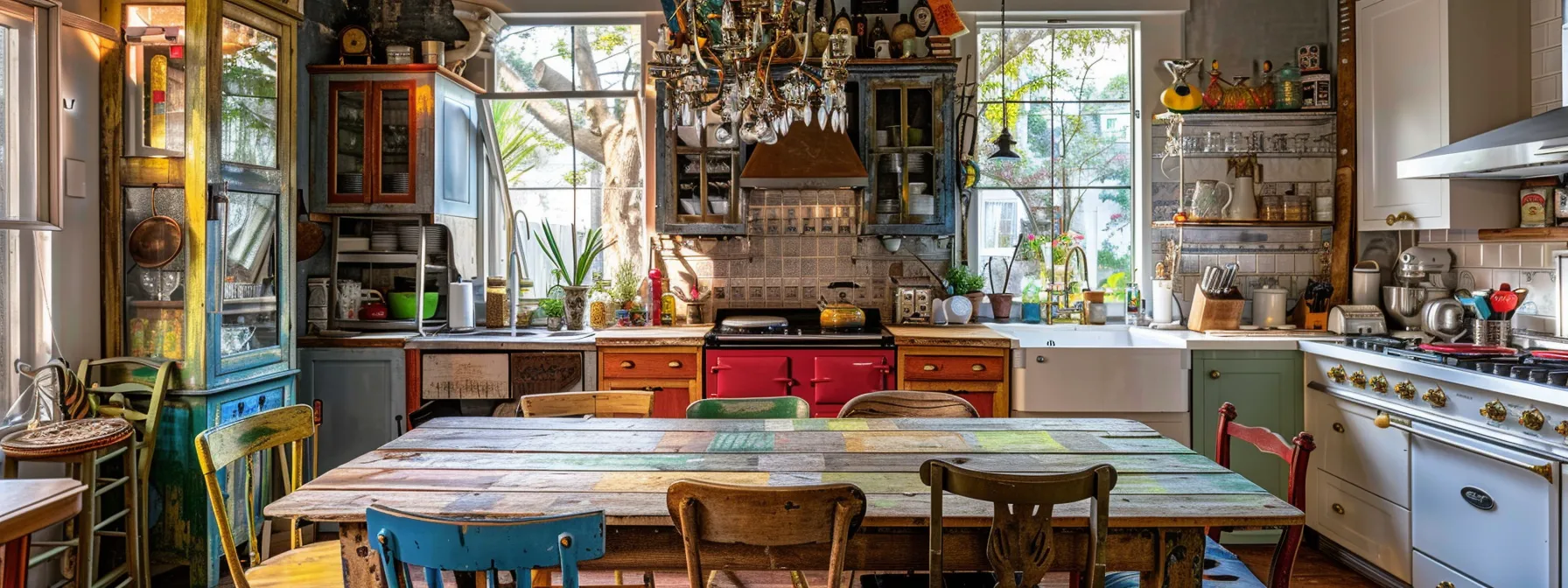
Incorporating recycled and upcycled elements into kitchen design enhances sustainability while adding unique character. Repurposing vintage furniture can create functional and stylish pieces, while utilizing reclaimed materials for flooring and backsplashes promotes eco-friendly practices. DIY projects with salvaged materials offer creative solutions, and supporting local craftsmen and sustainable brands fosters community. Balancing aesthetics with environmental responsibility ensures a beautiful kitchen that reflects personal values.
Repurposing vintage furniture in kitchen design not only adds character but also promotes sustainability. Homeowners can transform old tables, chairs, or cabinets into functional pieces that fit their modern kitchen aesthetics. For example, an antique table can serve as a unique dining area, while vintage cabinets can be refinished to provide stylish storage solutions, reducing the need for new materials.
This approach to kitchen design allows homeowners to express their personal style while minimizing waste. By choosing to upcycle vintage furniture, they contribute to a circular economy, where items are reused rather than discarded. This not only supports eco-friendly practices but also creates a warm and inviting atmosphere that reflects individual tastes and values.
Utilizing reclaimed materials for flooring and backsplashes is an effective way to enhance the sustainability of a kitchen design. Reclaimed wood, for instance, not only adds warmth and character but also reduces the demand for new timber, which helps in conserving forests. Homeowners can find unique pieces that tell a story, making their kitchen both stylish and environmentally friendly.
Incorporating reclaimed materials can also lead to cost savings, as these items are often more affordable than new alternatives. For backsplashes, using reclaimed tiles or bricks can create a stunning focal point while minimizing waste. By choosing these eco-friendly options, homeowners can achieve a beautiful kitchen that aligns with their commitment to sustainable living:
DIY projects with salvaged materials offer homeowners a practical way to enhance their kitchen’s sustainability while adding unique character. For instance, repurposing old wooden pallets into open shelving can create a rustic look that is both functional and stylish. This approach not only reduces waste but also allows homeowners to express their creativity and personal style in their kitchen design.
Another effective DIY project involves transforming vintage doors into a charming kitchen island or a distinctive dining table. By refinishing these salvaged pieces, homeowners can create focal points that reflect their values of sustainability and resourcefulness. Engaging in such projects not only contributes to eco-friendly living but also fosters a sense of accomplishment and pride in creating a personalized kitchen space.
Supporting local craftsmen and sustainable brands is a vital aspect of eco-friendly kitchen design. By choosing to purchase from local artisans, homeowners not only contribute to the local economy but also reduce the carbon footprint associated with transporting goods over long distances. This practice promotes the use of sustainable materials and techniques, ensuring that the kitchen reflects a commitment to environmental responsibility.
Additionally, local craftsmen often offer unique, handcrafted items that add character and charm to a kitchen. Homeowners can find one-of-a-kind pieces that align with their personal style while supporting sustainable practices. By investing in these local products, they create a kitchen that is not only functional but also a true reflection of their values and dedication to sustainable living.
Balancing aesthetics with environmental responsibility is crucial in eco-friendly kitchen design. Homeowners can achieve this by selecting recycled and upcycled materials that not only enhance the visual appeal of their kitchens but also contribute to sustainability. For instance, using reclaimed wood for cabinetry or countertops adds warmth and character while reducing the demand for new resources, making it a stylish and responsible choice.
Incorporating unique, upcycled elements allows homeowners to express their personal style while supporting eco-friendly practices. Vintage furniture can be transformed into functional kitchen pieces, creating a distinctive look that stands out. By prioritizing both beauty and sustainability, homeowners can create a kitchen that reflects their values and commitment to responsible living:
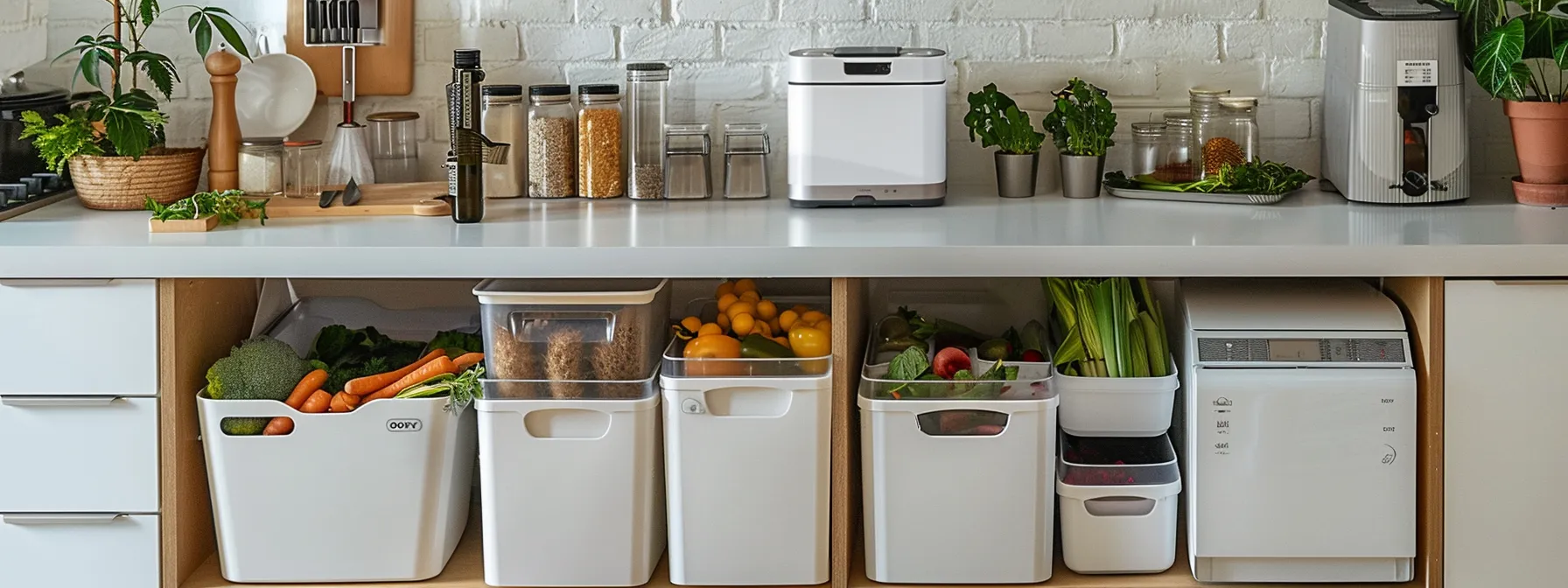
Designing for waste reduction and recycling is a vital aspect of eco-friendly kitchen design. Homeowners can set up integrated recycling centers to streamline waste management, while composting organic waste helps minimize landfill contributions. Choosing reusable over disposable kitchen items and organizing storage effectively can significantly reduce food waste. Encouraging sustainable habits among family members further enhances these efforts, creating a kitchen that supports responsible living.
Setting up integrated recycling centers in the kitchen is a practical step toward promoting sustainable living. Homeowners can designate specific areas for different types of recyclables, such as paper, plastics, and glass, making it easier to sort waste during meal preparation. By incorporating pull-out bins or built-in cabinets, they can maintain a clean and organized space while encouraging family members to participate in recycling efforts.
To enhance the effectiveness of these recycling centers, homeowners should place them near high-traffic areas, such as the sink or prep station. This strategic placement not only simplifies the recycling process but also serves as a constant reminder to reduce waste. By creating a user-friendly recycling system, homeowners can significantly contribute to waste reduction and foster a culture of sustainability within their households.
Composting organic waste in the kitchen is a practical step toward reducing landfill contributions and promoting sustainable living. Homeowners can set up a designated compost bin to collect food scraps, such as vegetable peels, coffee grounds, and eggshells. This not only minimizes waste but also creates nutrient-rich compost that can be used to enrich garden soil, supporting a healthier ecosystem.
To make composting more accessible, homeowners can choose countertop compost bins with odor-control features or even integrate a composting system into their kitchen design. By educating family members about what can be composted, they can foster a culture of sustainability at home. This simple practice not only helps in waste reduction but also empowers homeowners to contribute positively to the environment while enhancing their kitchen’s functionality.
Choosing reusable over disposable kitchen items is a fundamental step in promoting sustainable living. By opting for items like cloth napkins, stainless steel straws, and glass containers, homeowners can significantly reduce waste generated from single-use products. This shift not only minimizes the environmental impact but also encourages a more mindful approach to daily kitchen activities, ultimately leading to a cleaner and healthier home.
Incorporating reusable items into kitchen design can also enhance functionality and aesthetics. For example, using stylish glass jars for storage not only keeps food fresh but also adds a decorative touch to the kitchen. Homeowners can create a more organized and visually appealing space while supporting eco-friendly practices, making their kitchens both practical and sustainable.
Organizing storage effectively in the kitchen is crucial for minimizing food waste. Homeowners can implement clear labeling systems for pantry items, ensuring that older products are used first. This practice not only helps in tracking expiration dates but also encourages meal planning, which can significantly reduce the likelihood of food spoilage.
Additionally, utilizing transparent containers for storing fruits and vegetables allows homeowners to easily see what they have on hand, promoting timely consumption. Incorporating designated sections in the refrigerator for leftovers and fresh produce can further streamline the cooking process and encourage the use of ingredients before they go bad. By prioritizing organization, homeowners can create a more efficient kitchen that supports sustainable living:
Encouraging sustainable habits among family members is essential for creating an eco-friendly kitchen environment. Homeowners can lead by example, demonstrating the importance of recycling and composting through daily practices. Simple actions, such as sorting recyclables together or discussing the benefits of reducing food waste, can instill a sense of responsibility and awareness in children and adults alike.
To further promote these habits, families can establish a reward system for sustainable actions, such as using reusable bags or minimizing single-use plastics. This approach not only makes sustainability engaging but also reinforces positive behaviors. By fostering a culture of eco-consciousness at home, families can contribute to waste reduction and create a kitchen that reflects their commitment to sustainable living:
Eco-friendly kitchen design is crucial for promoting sustainable living and reducing environmental impact. By choosing sustainable materials, energy-efficient appliances, and implementing water conservation strategies, homeowners can create a kitchen that reflects their commitment to the planet. Incorporating practices like recycling, composting, and supporting local craftsmen further enhances sustainability efforts. Embracing these essential tips not only leads to a healthier home but also contributes to a more responsible and eco-conscious lifestyle.
